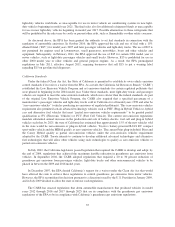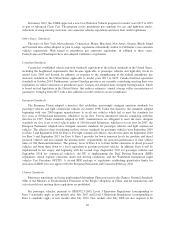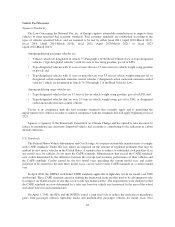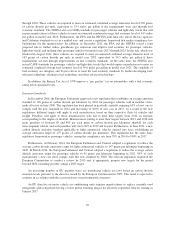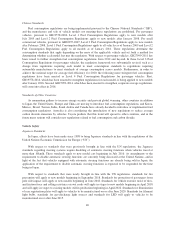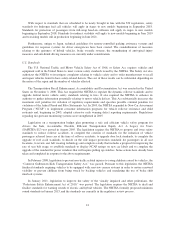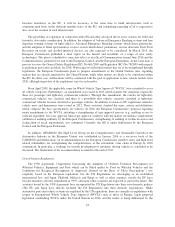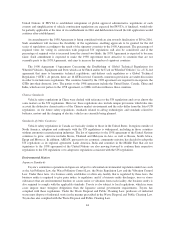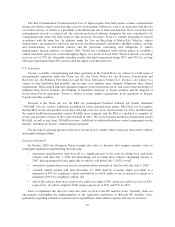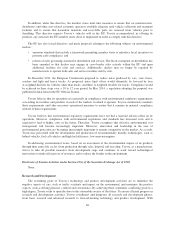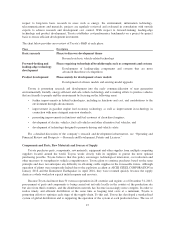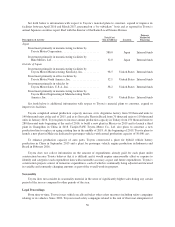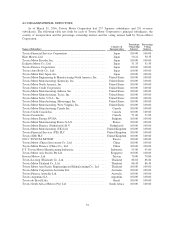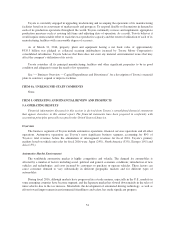Toyota 2015 Annual Report Download - page 50
Download and view the complete annual report
Please find page 50 of the 2015 Toyota annual report below. You can navigate through the pages in the report by either clicking on the pages listed below, or by using the keyword search tool below to find specific information within the annual report.The Soil Contamination Countermeasures Law of Japan requires that land owners conduct contamination
testing and submit a report at the time they cease to use hazardous substances, such as in connection with the sale
of a former factory, or if there is a possibility of health hazards due to land contamination. If it is found that land
contamination exceeds a certain level, the relevant prefectural authority designates the area considered to be
contaminated and orders the land owner to take necessary measures. Toyota is suitably managing its land in
accordance with the same law. In addition, under the Law on Recycling of End-of-Life Vehicles, vehicle
manufacturers are required to take back and recycle specified materials (automotive shredder residues, air bags
and fluorocarbons) of end-of-life vehicles and the provisions concerning such obligations of vehicle
manufacturers became effective in January 2005. Toyota has coordinated with relevant parties to establish a
vehicle take-back and recycle system throughout Japan. As a result, in fiscal 2016, Toyota achieved a recycling/
recovery rate of 97% for automobile shredder residue (the legal requirement being 70%) and 93% for air bags
(the legal requirement being 85%) and reached the targets set forth in this law.
U.S. Standards
Toyota’s assembly, manufacturing and other operations in the United States are subject to a wide range of
environmental regulation under the Clean Air Act, the Clean Water Act, the Resource Conservation and
Recovery Act, the Pollution Prevention Act and the Toxic Substances Control Act. Toyota is also subject to a
variety of state legislation that parallels, and in some cases imposes more stringent obligations than, federal
requirements. These federal and state regulations impose severe restrictions on air- and water-borne discharges of
pollution from Toyota facilities, the handling of hazardous materials at Toyota facilities and the disposal of
wastes from Toyota operations. Toyota is subject to many similar requirements in its operations in Europe,
Canada and other countries.
Pursuant to the Clean Air Act, the EPA has promulgated National Ambient Air Quality Standards
(“NAAQS”) for six “criteria” pollutants, including for ozone and particulate matter. The Clean Air Act requires
that the EPA review and possibly revise these NAAQS every five years. On December 14, 2012, the EPA made
the annual health-based particulate matter NAAQS more stringent, and the EPA is scheduled to complete its
review and possible revision of the ozone NAAQS in 2015. The revised annual health-based particulate matter
NAAQS, as well as any future NAAQS revisions, could lead to additional pollution control requirements on the
industry, including on Toyota’s manufacturing operations.
Toyota expects growing pressure in the next several years to further reduce emissions from motor vehicles
and manufacturing facilities.
European Standards
In October 2000, the European Union brought into effect a directive that requires member states to
promulgate regulations implementing the following:
• automotive manufacturers shall bear all or a significant part of the costs for taking back end-of-life
vehicles sold after July 1, 2002 and dismantling and recycling those vehicles. Beginning January 1,
2007, this requirement became applicable to vehicles sold before July 1, 2002 as well;
• automotive manufacturers may not use certain hazardous materials in vehicles sold after July 1, 2003;
• certified vehicle models sold after December 15, 2008 shall be re-usable and/or recyclable to a
minimum of 85% by weight per vehicle and shall be re-usable and/or re-use as material or energy to a
minimum of 95% by weight per vehicle; and
• end-of-life vehicles must meet actual re-use and/or recycling of 80% and re-use and/or recovery of 85%,
respectively, of vehicle weight by 2006, rising respectively to 85% and 95% by 2015.
Laws to implement this directive came into effect in each of the EU member states. Currently, there are
uncertainties surrounding the implementation of the applicable regulations in different EU member states,
particularly regarding automotive manufacturer responsibilities and resultant expenses that may be incurred.
45


